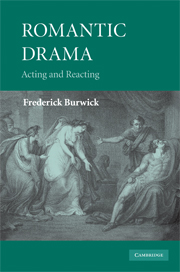Book contents
- Frontmatter
- Contents
- List of illustrations
- Acknowledgments
- Introduction
- 1 Periscopes into the theatre
- 2 Nationalism and national character
- 3 Genre: the realism of fantasy, the fantasy of realism
- 4 Acting: histrionics, and dissimulation
- 5 Transvestites, lovers, monsters: character and sexuality
- 6 Setting: where and elsewhere
- 7 Gothic and anti-Gothic: comedy and horror
- 8 Blue-Beard's castle: mischief and misogyny
- 9 Vampires in kilts
- Notes
- Bibliography
- Index
2 - Nationalism and national character
Published online by Cambridge University Press: 04 August 2010
- Frontmatter
- Contents
- List of illustrations
- Acknowledgments
- Introduction
- 1 Periscopes into the theatre
- 2 Nationalism and national character
- 3 Genre: the realism of fantasy, the fantasy of realism
- 4 Acting: histrionics, and dissimulation
- 5 Transvestites, lovers, monsters: character and sexuality
- 6 Setting: where and elsewhere
- 7 Gothic and anti-Gothic: comedy and horror
- 8 Blue-Beard's castle: mischief and misogyny
- 9 Vampires in kilts
- Notes
- Bibliography
- Index
Summary
Foremost among the charges assigned to John Larpent, Examiner of Plays from 1778 until 1824, was to protect Church and State from demeaning references to clergy, monarchy, or aristocracy. Other groups, however, might be ridiculed with impunity. The worst sort of assaults, from our contemporary perspective, were directed toward foreigners and minorities. National and ethnic stereotypes were appropriated blatantly as stock characters: negro, Jew, Scotsman, Irishman, Frenchman, German, Italian were often prefabricated from prejudice.
There were, of course, attempts to break down the prevailing xenophobia. George Colman's Inkle and Yarico (Haymarket, August 4, 1787) lent support to the abolitionist movement. Ira Aldridge, the negro actor who performed in anti-slavery plays as well as in the title roles of both Hamlet and Othello, contributed significantly to a broader public understanding of racial identity. Amidst a horde of stage Jews as comic caricatures and cunning villains, Edmund Kean attempted a sympathetic portrayal of Shylock. John Braham, lead cantor of the Great Synagogue of London, had also established himself as the leading stage tenor of the age. Similarly, Isaac Nathan found success as a Jewish composer through his collaboration with Lord Byron on the Hebrew Melodies (1815–16), and then with James Kenney on Sweethearts and Wives (Haymarket, July 27, 1823) and The Alcaid (Haymarket, August 10, 1824). Among the national, cultural, racial, and ethnic characters appearing in the plays of the Romantic period, representation of the French occurred under unique circumstances of political and ideological conflict.
- Type
- Chapter
- Information
- Romantic DramaActing and Reacting, pp. 33 - 55Publisher: Cambridge University PressPrint publication year: 2009



